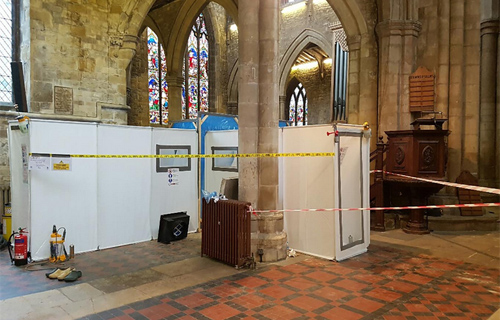Facts You Should Know about Asbestos in Churches

Asbestos, a naturally occurring but dangerous mineral, when inhaled over an extended period of time could lead to serious diseases including cancer of the lung and chest lining. Asbestos was banned in the year 1985, and the use of this material in the construction and refurbishment of buildings is considered illegal currently.
Tons of asbestos was used in the past and much of it is still found in some churches, especially if constructed, refurbished, or altered during the twentieth century. There is no risk if the asbestos is present in good condition and is not going to be damaged or disturbed. But, if done so, the asbestos fibers get released into the air and when inhaled on a routine basis, these fibers get stuck in the lining of the lungs, heart, and abdomen leading to chronic diseases such as asbestosis, mesothelioma, and pleural plaques.
Asbestos in Churches
Asbestos was mainly used in churches for soundproofing and prevention of fire hazards. Though soundproofing is not often associated with asbestos, in the past, it was added to acoustical panels for strength. Acoustical panels were fitted onto walls and ceilings in order to dampen the echo and absorb the reverberation of music inside churches. Asbestos will also be found in flooring or ceiling tiles, heating systems such as boilers and steam pipes, roofing materials, pipe organs, bellows, and organ blowers used in churches. Most often, asbestos may be found painted over or in combination with other materials.
Asbestos was also added in decorative and acoustical plaster that was used in churches during the 19th and 20th century. Acoustical plaster, in its dense, heavy form was directly applied over concrete and would reduce echoes. Another form which is lighter and more porous was filled in the gap before the concrete. This would allow sound to pass through the ceiling and was ideal in large gathering spaces such as churches. If you happen to see a popcorn texture on your ceiling, you are likely to be at risk of asbestos exposure as it indicates acoustical plaster being used in the ceiling.
Who Is at Asbestos Exposure Risk in Churches?
The maintenance and repair workers are the ones who are at the greatest risk of getting exposed to asbestos in churches. However, any individual who works at a church, particularly old churches, will encounter asbestos products, and exposure is likely when these materials get damaged or disturbed. The people carrying out general maintenance and repair of church buildings including electricians, builders, roofers, painters, plumbers, plasterers, gas fitters, and heating engineers are at risk of asbestos exposure. In addition, when asbestos products are in poor condition or damaged, even people who are present in the building are at risk of exposure.
Where to Look Out for Asbestos Hazards?
Here is a list that includes areas within a church with potential asbestos hazard:
- Loose asbestos that was used in the loft as insulation
- Asbestos sprayed in ducts and structural steelwork as a fire retardant
- Asbestos lagging around pipes and boilers as thermal insulation
- Asbestos insulating boards (AIB) used as wall partitions, in ducts, ceilings, wall panels, and soffits
- Roofing, wall cladding, rainwater pipes, water tanks made up of asbestos cement products
- Decorative plasters and paints
Precautions to Be Taken to Avoid Asbestos Exposure in Churches
Certain precautions that help reduce asbestos exposure at church buildings include:
- Removal of asbestos-containing materials, particularly if in poor condition or likely to be disturbed.
- Encapsulating or repairing damaged asbestos-containing materials if they need to be left in place
- Regular monitoring of asbestos-containing materials
- Labeling the asbestos-containing materials wherever possible and providing information about its location to workers (builders and painters)
